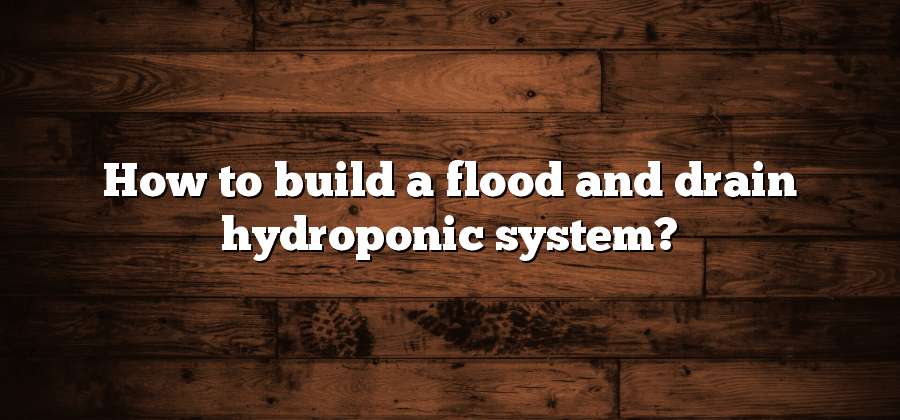Components needed for flood and drain hydroponic system
Every successful flood and drain hydroponic system is built upon the foundation of essential components. These components ensure the proper functioning and productivity of the system. One crucial component is a high-quality grow tray, which serves as the base for your plants. It should be sturdy, durable, and able to withstand the weight of the plants, growing medium, and water. Additionally, you will need a flood table, which holds the nutrient solution during the flood cycle. It should be made of food-safe materials and have a waterproof design to prevent leaks and potential damage to your surroundings. Another crucial component is the grow bed, which houses the growing medium and provides support for the plants’ root systems. The grow bed should have drainage capabilities to allow excess water to flow out during the drain cycle.
Selecting the right growing medium for your hydroponic system
When it comes to setting up a hydroponic system, selecting the right growing medium is crucial for the success of your plants. The growing medium serves as a support system for the plant roots and helps to retain moisture and nutrients. There are various options available, each with its own benefits and considerations.
One popular choice for hydroponic systems is clay pebbles. These lightweight and porous pebbles provide excellent drainage and aeration for the roots, preventing waterlogging and promoting oxygenation. Another option is rockwool, a mineral-based material that offers good water retention and can be easily manipulated to fit different plant sizes. Coco coir, made from coconut husks, is also a widely used medium as it is sustainable, holds moisture well, and provides good airflow. As you select the right growing medium for your hydroponic system, consider the specific requirements of your plants, the system you are using, and your personal preferences.
Choosing the appropriate flood and drain system size for your space
One of the crucial considerations when setting up a flood and drain hydroponic system is selecting the appropriate size for your space. The size of your system will greatly impact the efficiency and productivity of your plants. It is essential to choose a size that not only accommodates your available space but also provides enough room for your plants to grow and thrive.
When determining the appropriate system size, you need to take into account the number of plants you intend to grow and their specific requirements. Consider the space the plants will need to develop their roots, as well as the height and width they will reach at maturity. Additionally, factor in any future expansions or changes in your gardening plans. By selecting a system size that is suitable for both your current needs and potential future growth, you can ensure a successful and sustainable hydroponic setup.
Determining the best location for your flood and drain hydroponic system
Determining the best location for your flood and drain hydroponic system is crucial for maximizing its potential. When selecting the ideal spot, it’s essential to consider the availability of natural light. You want to find a location that receives ample sunlight throughout the day, as this is essential for the growth and development of your plants. If your hydroponic system is set up indoors, make sure to position it near a window or invest in grow lights to provide the necessary light spectrum for photosynthesis.
Another important factor to consider when determining the location is the accessibility to water and electricity sources. Since the flood and drain system requires a constant supply of water, it’s convenient to position it near a water source, such as a faucet or hose. This will eliminate the need for long hoses or complex plumbing arrangements, making it easier to maintain and operate your system. Additionally, ensure that there is access to electrical outlets nearby, as you will need them to power the pump and any supplementary equipment.
By carefully assessing these factors, you can find the ideal location for your flood and drain hydroponic system. Remember, a well-placed system will not only ensure the optimal growth of your plants but also make it easier for you to monitor and maintain the system effectively.
Setting up the flood and drain system’s reservoir and pump
Once you have selected and prepared the appropriate flood and drain hydroponic system, it’s time to set up the reservoir and pump. These components play a crucial role in the proper functioning of your system, ensuring a continuous flow of nutrient solution to your plants.
Firstly, you need to choose a suitable reservoir that can accommodate the required volume of nutrient solution for your hydroponic setup. It is essential to opt for a container made of food-grade materials to prevent any potential contamination. Ensure that the reservoir has a lid to minimize evaporation and keep light out to avoid algae growth. Additionally, consider installing a float valve or an automatic filling system to maintain the nutrient solution at the desired level, making it easier to manage your hydroponic system.
Now, let’s talk about the pump. Selecting the right pump is crucial for maintaining proper circulation and a reliable flood and drain cycle. It is recommended to choose a pump that is specifically designed for hydroponic systems. Look for a pump that can handle the desired flow rate and has adjustable settings for flood and drain cycles. Properly position the pump in the reservoir, ensuring that it is fully submerged and securely attached to prevent any leaks or movement during operation.
In the next sections of the article, we will discuss the importance of regular maintenance and monitoring of the reservoir and pump, as well as other essential factors to consider for a successful flood and drain hydroponic system.






